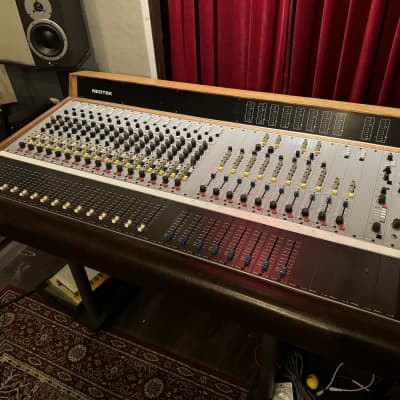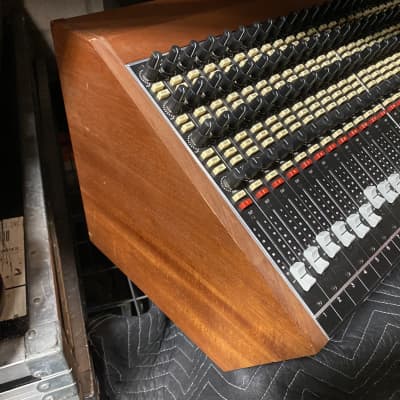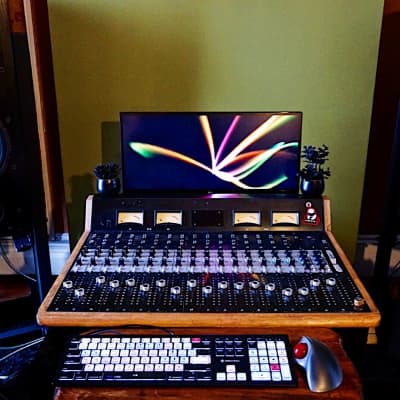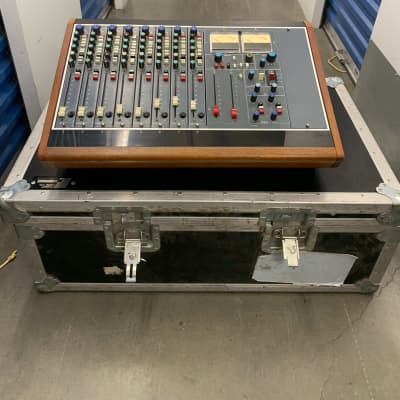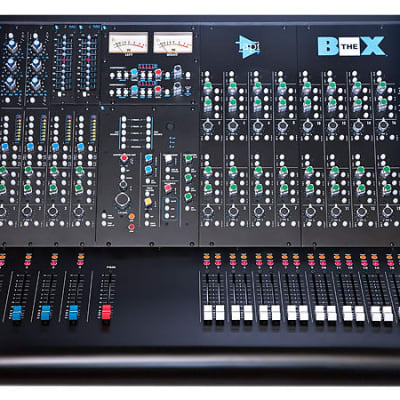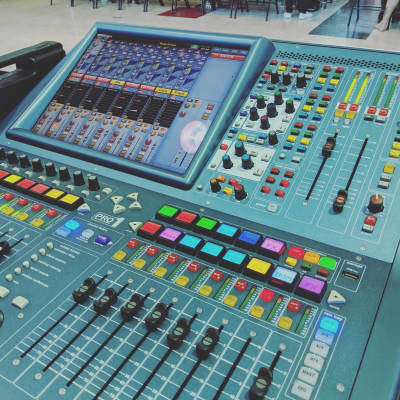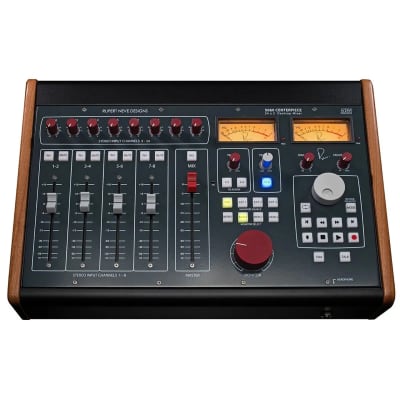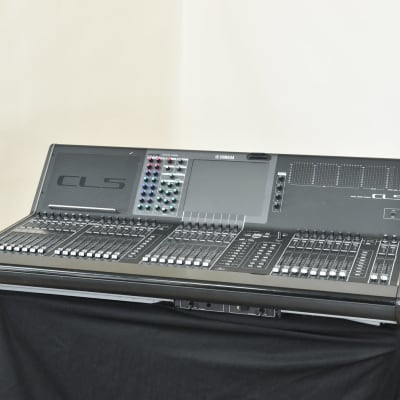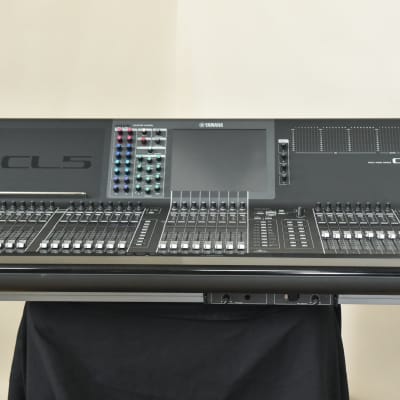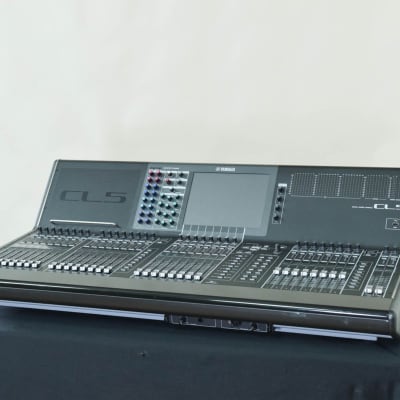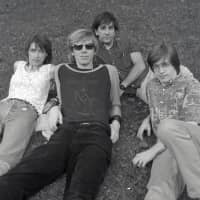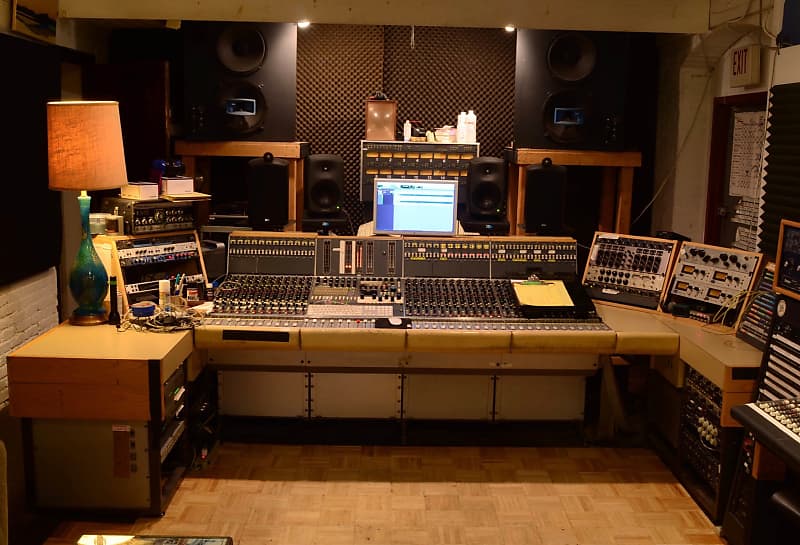

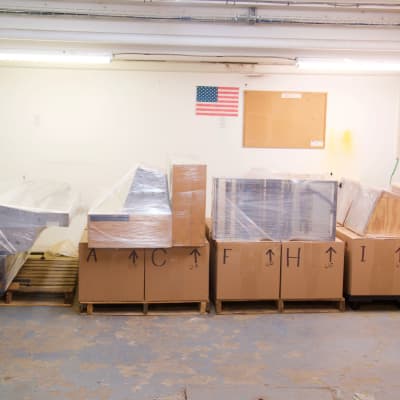
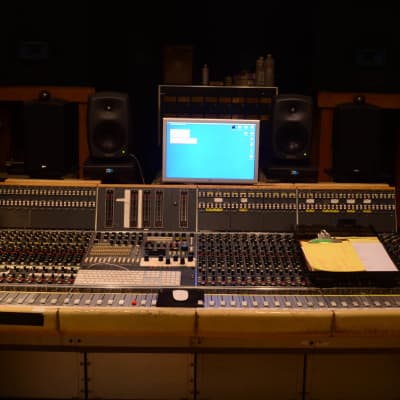
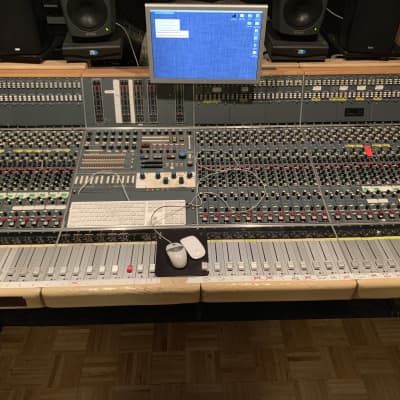
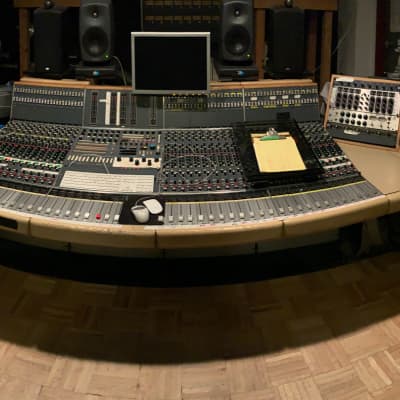
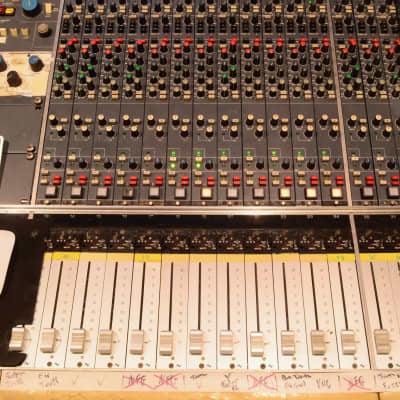
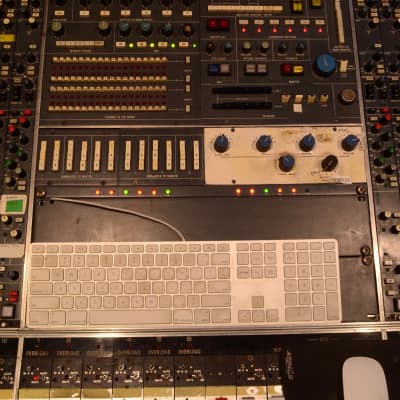
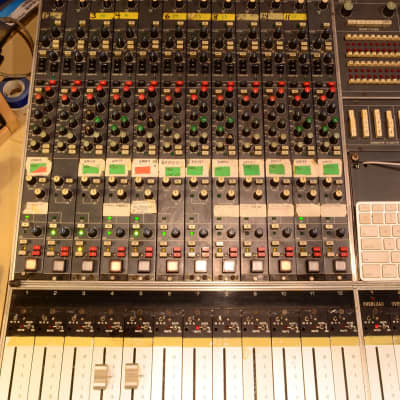
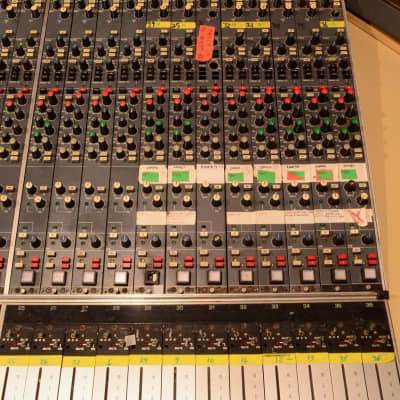
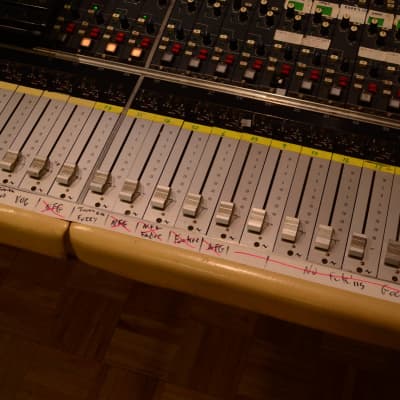
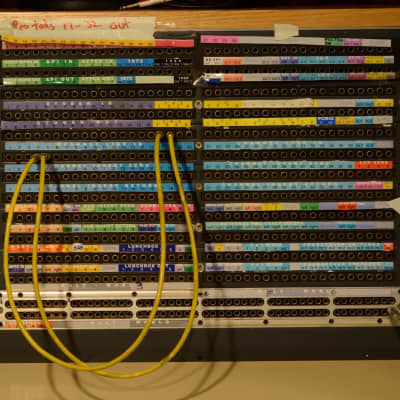
BEFORE READING ON
- This board is currently located in Hoboken NJ with Sonic Youth -- NOT CHICAGO IL.
- Reverb will work with both Sonic Youth and the buyer to safely and effectively freight this item should this be necessary. Shipping in the Continental United States only.
Here we have Sonic Youth’s 1980s Neve A10047 Custom 51-Series Console located at Echo Cañon West, July 2019. Insane!
When Sonic Youth needed to replace the console for their Manhattan studio in 1999, they acquired this National Film Board of Canada-commissioned custom Neve, one of two custom consoles. The console could mix in the then-still-novel 5.1 surround format. The consoles were expensive, carefully-pieced-together partly from existing Neve components (the channels were largely built from modified modules from the 5106/5116 desks) while other sections were completely custom, created specifically for the NFB.
Finally, the whole thing was contained in a brilliantly extravagant wrap-around producer’s desk setup, with integrated 19” racks and the best patch-bay location anyone had ever seen. The console had no mic preamps of its own, as they would be unnecessary for surround film mixing.
This console found its way from Montreal to Manhattan, becoming the catalyst to an almost total-studio rebuild. This upgraded Echo Cañon studio came online in early 2000, and the first project to be done on it was the score to Allison Anders’ Things Behind The Sun. Very quickly it became apparent that the console’s brilliantly-modular design would allow it to be tweaked and experimented-with in true SY fashion. Channel routing was altered, a new stereo mix bus was built with separate stereo panners for each channel. But most importantly, the console sounded good. Like, really good.
The EQs were fabulous, and the mix bus had just the right amount of oomph without being overbearing.
As for the second custom console created for the NFB, it was taken out of commission and disposed of (!). Some of the channel modules were saved from the recycler and became spares for this console. There are over a dozen spare channels included with this console in varying states of disrepair.
Despite being so close, the studio’s contents were largely spared of damage on Sept 11, 2001, but excess overheating caused by a layer of drywall dust combined with a few unusually-severe power grid surges meant that the console needed to have many of its electrolytic capacitors replaced, so a full cleaning and recap’ing occurred in 2002. It was going to have to happen at some point anyway; the console sounded better than ever and the experiments/upgrades continued.
A custom monitor source/destination switching section was designed, built, and installed, and it worked beautifully. In the spring of 2006, the studio was packed up and moved straight across the river to Hoboken. The console went back into service, and was given a good going-over in 2007 to make sure that all 36 channels were working well. There were a few bugs starting to creep into the console by this point – some of the switches were getting dirty and the latching pins were starting to go, but we could work through it and keep going and the console still sounded amazing. There’s some serious iron in that mix bus.
After a period in which the console was used less and less, the switch latching-pin problem became an epidemic, and a few of the now-already-15-year-old capacitors from 2002 started to drift. We estimate the board will need at least a partial recap and re-switch, and many of the ribbon cables inside the channels will need to be replaced.
The Board is: a 36x6x6 line mixer with 4 aux sends per channel, all switchable between pre and post-fader, and a 4-band EQ with the top and bottom bands switchable between peak and shelf. It’s what the V/V2/V3/VR/VX-series and later 88R EQs are based-on, but without the variable bandwidth control. For mixing, it’s a great-sounding eq; very transparent and with none of the scrape-y harshness you get boosting the highs on say, a 1073 or 1084. Each channel also has sweepable high and lowpass filters and a single insert send/return that’s switchable between pre and post-EQ, and the channel’s line input has a 16dB range of gain. Each channel has a Left-Centre-Right panner with divergence control, as well as a second stereo panner, and has both mono PFL and stereo SIP soloing, and there are two pretty-hip mute group assigns that you can trigger from buttons in the master section.
All of this feeds into two 6-channel busses (originally designated for 5.1 surround but the added stereo panners pan between odd and even-numbered buses); a Master bus and a Submaster bus. The Submaster has its own set of insert sends/returns and it can feed into the Master, so they could compress a 5.1 music/ambience track behind a dialog track or whatever, but you could use the Submasters like 3 stereo subgroup buses for compressing drums, and with some trick patching, you could use the other two Master pairs as well, for a total of 5 stereo subgroup busses plus another left over for a stereo mix bus. Or you could think of it as 10 mono tape-input buses and a stereo Master. The monitor section can feed any of 24 sources (Masters, Submasters, Auxes, and a dozen external inputs) to any of 4 sets of speakers, and there’s a dedicated headphone cue output section with talkback. Lastly, there’s a test-tone oscillator and glowy plasma meters that are seriously post-steampunk.
What’s the deal with the automation?
The console came with the original NECAM 96 moving-fader automation, but it was outmoded by the time we acquired the board and we never even tried hooking it up beyond feeding power to the faders and VCAs (which seemed necessary for them to pass audio). We no longer have the NECAM 96 gear.
The console comes with over a dozen binders of documentation. This is basically the whole manual set for both National Film Board consoles, and it seems that despite some small differences between the two consoles, some components were freely swapped between them, so we have mostly one console with some bits from the other. Therefore, both manual sets are worth keeping around. You could wallpaper your house with all the large diagrams (and for the really nerdy, there are the initials of a few rather well-known present and past Neve engineers on some of those diagrams).
Does it come with spares?
Other than the spare channels mentioned above, there are very few spare parts. Most of the few spare electrolytics we had left over are now already 20 years old, so you wouldn’t want to use them for a recap anyway. The old ITT dialistat switches are the bane of this console’s existence, and you’ll likely have to find a source of new ones to really get this thing back to full-awesome.
That’s a really important thing to know.
Power supplies?
The console uses two huge Kingshill power supplies like the V/VR-series uses, with the voltage sensing on each feed. We have a known-working pair of them, plus a third that may or may not have something wrong with it. I heard a rumour that Kingshill wasn’t making these things anymore, and when last I checked, they were worth a small fortune to be used as V-series spares. They connect to the console with included 50-foot wrapped cable bundles. The NECAM faders have their own rather large Neve supplies (again, we have one working one and one spare of unknown condition) and they have a 100-foot cable. All of the power supplies are very heavy, but not particularly noisy.
Could I buy it and ‘part it out’?
Yeah, you could. It would be a bummer in a way to see that happen to what is more or less a unique musical instrument, but I suspect the modules for the channels could be valuable for people who need 5104/5106/5114/5116 spares, or if someone was really good at building buffer amps, they could rack up the channel sections and sell them as outboard really similar to the Neve Prism racks that were around in the ‘90s. The power supplies would likely be particularly sought-after, and there’s probably some people out there still using the trick NTP plasma meters and the motorized NECAM faders. If you do it, it’s on your conscience.
How big is it? Is it heavy? How would I move it?
The console main frame is currently in two sections; a leftmost single bucket and the rest of it is the right three buckets tied together. This way it will fit vertically through a 36” doorway if you have the right clearance on either side. Two or three people can kinda lift it, but you don’t want to have to move it very far like that. We rolled it around on dollies. The side racks and desktops can be carried by two people easily. Right now it’s on forklift pallets/skids, with the frames, furniture and power supplies wrapped in stretch wrap to keep them clean, and the channels and other components bubble-wrapped and sealed in about 12 large cardboard boxes that are heavy enough that you wouldn’t want to lift them, and you definitely don’t want to stack them for fear of crushing their contents. If you want to stack this stuff high, you’ll need to send it to a crating company to double-box and crate it – it’s too fragile. As it is right now, a considerate trucking company with a good air-ride trailer, a pallet jack and a lot of moving pads could haul it out of the city as long as it didn’t have heavy stuff piled on top of it.
-- Timothy Glasgow, Lee Ranaldo, Aaron Mullan
SONIC YOUTH PROJECTS MADE ON THIS CONSOLE:
SPINHEAD SESSIONS 1986. Goofin Records, May 2016. CD/LP.
SONIC YOUTH•SMART BAR•1985. CD/LP. Goofin Records. 2013.
SYR9: Simon Werner a Disparu. Original Film Soundtrack. Sonic Youth Recordings. February 2011.
THE ETERNAL. Matador CD/LP. June 2009.
PAY NO MIND. 7” record. 2009
BATTERY PARK, NYC. 2008/9, reissued 2019.
HITS ARE FOR SQUARES. Starbucks Music. June 2008. Compilation.
SYR8. Sonic Youth Recordings. June 2008.
SYR7: J’accusse Ted Hughes/ Agnes B Musique April 2008
I’M NOT THERE, soundtrack. 2006/7.
DAYDREAM NATION DELUXE EDITION. Geffen/Universal. August 2007.
THE DESTROYED ROOM, B SIDES AND RARITIES. Geffen. CD. Dec 2006.
RATHER RIPPED. Geffen. CD. June 2006.
HELEN LUNDEBERG/EYELINER. 7” single. Goofin. June 2006.
MELBOURNE DIRECT. Saucerlike Records. 2005.
SYR6. Sonic Youth Recordings. October 2005.
GOO DELUXE EDITION. Geffen/Universal. August 2005
SONIC NURSE. Geffen. May 2004.
DIRTY DELUXE EDITION. Geffen/Universal. August 2003.
DEMONLOVER OST. Labels France, Nov 2002.
MURRAY STREET. Geffen. June 2002.
Many, many other records by SY and our friends were cut on this board-we’re currently compiling a complete list.
Reverb Buyer Protection
Reverb has your back if your item is lost, damaged, or doesn't match its description. Simply report any issues within 7 days and we'll help you get a full refund.Learn more about Reverb Buyer Protection.
| Listed | 5 years ago |
| Condition | Fair (Used) Fair condition gear should function but will show noticeable cosmetic damage or other issues.Learn more |
| Brand | |
| Model |
|
| Categories | |
| Year |
|
